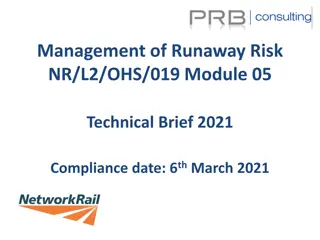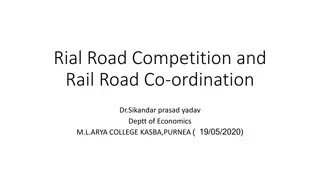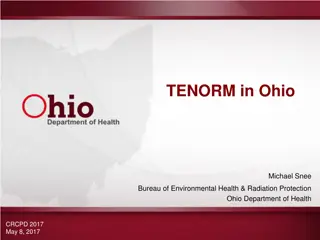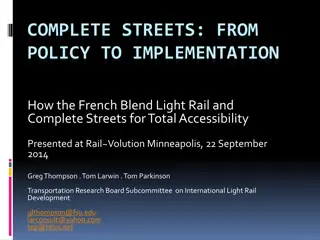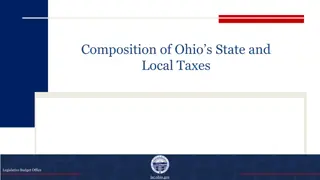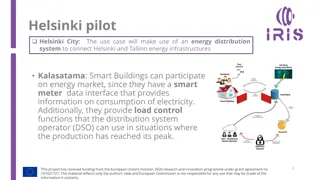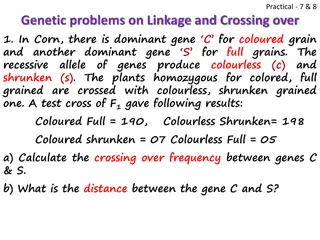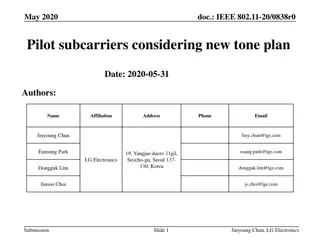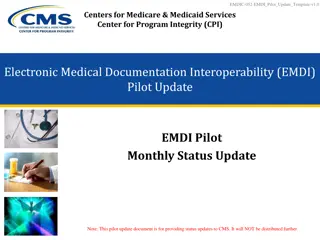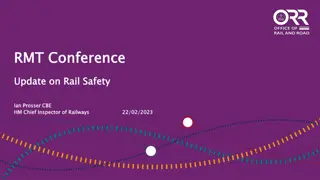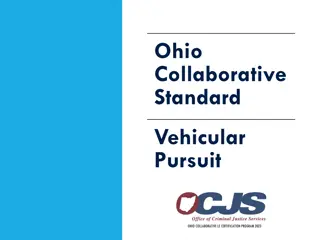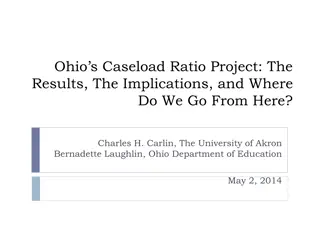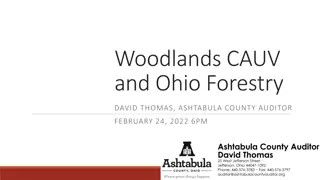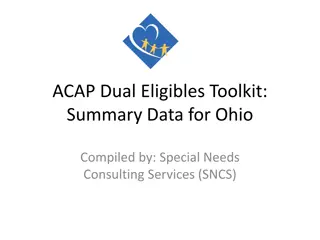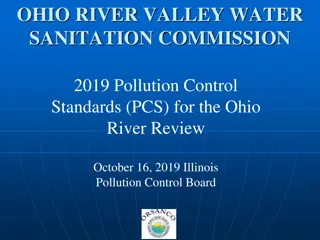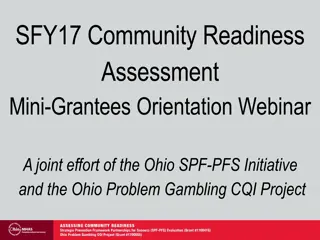Ohio Rail Grade Crossing Pilot Study Update August 2020
Ohio Rail Grade Crossing Pilot Study Update August 2020 provides insights into the methodology developed to evaluate rail-road grade crossings in Ohio, emphasizing adaptive capacity assessment tools and scoring. The study's objectives include assessing crossing importance, redundancy, and adaptability. The overview outlines phases such as identifying pilot areas, testing tools, and validation processes. The Adaptive Capacity Score Methodology evaluates factors like public importance, safety, and community cohesion. The future plan involves stakeholder workshops, metric development, and project evaluation. Contact information for the Ohio Rail Development Commission is also included.
Download Presentation

Please find below an Image/Link to download the presentation.
The content on the website is provided AS IS for your information and personal use only. It may not be sold, licensed, or shared on other websites without obtaining consent from the author. Download presentation by click this link. If you encounter any issues during the download, it is possible that the publisher has removed the file from their server.
E N D
Presentation Transcript
Ohio Rail Grade Crossing Pilot Study August 2020 Update
Study Objective Develop a methodology to evaluate rail-road grade crossings in Ohio and produce an adaptive capacity tool (and resulting score) that assesses at- grade crossing importance, redundancy, and overall adaptability. 2
Study Overview Phase 1 Inputs 7 Identify Pilot Areas 8 Develop/Test Adaptive Capacity Assessment Tool 9 Test and Validate Methodology in Pilot Areas 10 Final Report 3
Adaptive Capacity Score Methodology Adaptive Capacity Score Public Importance Delay to Road Users Redundancy Safety For For Motorized Road users For EMS/Fire Services Community Road Type (Functional Class) Facility Proximity to Crossing Community Cohesion Proximity to Grade- Separated Facility Rail Traffic Volume (Day Trains) PUCO/ODOT Grade Crossing Hazard Index Proximity to Signals, Sidings and Yards Road Road Demand (AADT) Demand (AADT) Road Demand (AADT) 4
Whats Next Final Stakeholder Workshop Final Report Final Evaluation Tool & User Manual Develop metrics to compare ACS outputs across a set of crossings (city/county/rail corridor/statewide) Incorporate ACS output into evaluation of potential projects 6
Contact Information Megan McClory Ohio Rail Development Commission Megan.McClory@dot.ohio.gov (614) 644-0289 7
Annex: Adaptive Capacity Score Methodology Adaptive Capacity Score Public Importance Delay to Road Users Redundancy Safety For For Motorized Road users For EMS/Fire Services Community Road Type (Functional Class) Facility Proximity to Crossing Community Cohesion Proximity to Grade- Separated Facility Rail Traffic Volume (Day Trains) PUCO/ODOT Grade Crossing Hazard Index Proximity to Signals, Sidings and Yards Road Road Demand (AADT) Demand (AADT) Road Demand (AADT) 8
Annex: Adaptive Capacity Score Methodology Public Importance For Motorized Road Users For EMS/Fire Services For Community wM+ wE+ wc Facility Proximity to Crossing Community Cohesion Road Type Inverse of the Distance to Hospitals / Fire Stations Percentage of population split by rail line Functional Class of a road Road Demand Average Annual Daily Traffic (AADT) Adaptive Capacity Score Legend: Component Public Importance Delay to Road Users Redundancy Safety Motorized Road Users To be included in the calculation of the Adaptive Capacity Score for Motorized Road Users only Sub-Component For For Motorized Road users For EMS/Fire Services Community Performance Category Facility Proximity to Crossing Community Cohesion Road Type (Functional Class) Proximity to Grade- Separated Facility Rail Traffic Volume (Day Trains) PUCO/ODOT Grade Crossing Hazard Index Performance Measure Proximity to Signals, Sidings and Yards Road Road Demand (AADT) Demand (AADT) Road Demand (AADT) 9
Annex: Adaptive Capacity Score Methodology Redundancy Proximity to Grade-Separated Facility Road Demand Distance to Closest Grade- Separated Crossing Average Annual Daily Traffic (AADT) Adaptive Capacity Score Legend: Component Public Importance Delay to Road Users Redundancy Safety Sub-Component For For Motorized Road users For EMS/Fire Services Community Performance Category Facility Proximity to Crossing Community Cohesion Road Type (Functional Class) Proximity to Grade- Separated Facility Rail Traffic Volume (Day Trains) PUCO/ODOT Grade Crossing Hazard Index Performance Measure Proximity to Signals, Sidings and Yards Road Road Demand (AADT) Demand (AADT) Road Demand (AADT) 10
Annex: Adaptive Capacity Score Methodology Delay to Road Users Proximity to Signals, Sidings and Yards Rail Traffic Volume Road Demand Average Annual Daily Traffic (AADT) Inverse distance to closest rail signal, yard or siding Number of Day Trains Adaptive Capacity Score Legend: Component Public Importance Delay to Road Users Redundancy Safety Sub-Component For For Motorized Road users For EMS/Fire Services Community Performance Category Facility Proximity to Crossing Community Cohesion Road Type (Functional Class) Proximity to Grade- Separated Facility Rail Traffic Volume (Day Trains) PUCO/ODOT Grade Crossing Hazard Index Performance Measure Proximity to Signals, Sidings and Yards Road Road Demand (AADT) Demand (AADT) Road Demand (AADT) 11
Annex: Adaptive Capacity Score Methodology Safety PUCO/ODOT Grade Crossing Hazard Index PUCO/ODOT Hazard Index Adaptive Capacity Score Legend: Component Public Importance Delay to Road Users Redundancy Safety Sub-Component For For Motorized Road users For EMS/Fire Services Community Performance Category Facility Proximity to Crossing Community Cohesion Road Type (Functional Class) Proximity to Grade- Separated Facility PUCO/ODOT Grade Crossing Hazard Index Rail Traffic Volume (Day Trains) Performance Measure Proximity to Signals, Sidings and Yards Road Road Demand (AADT) Demand (AADT) Road Demand (AADT) 12


